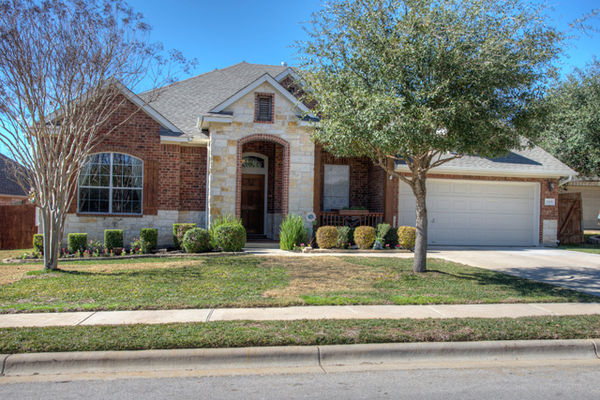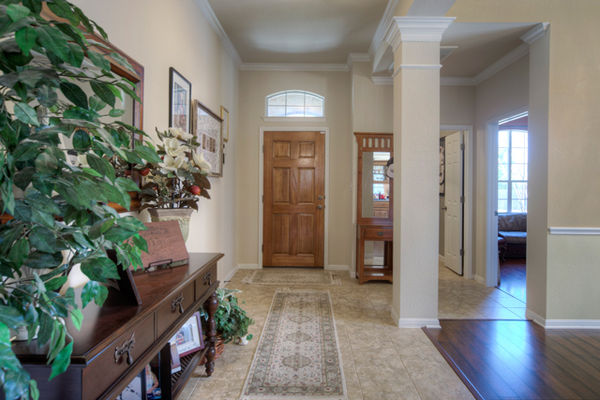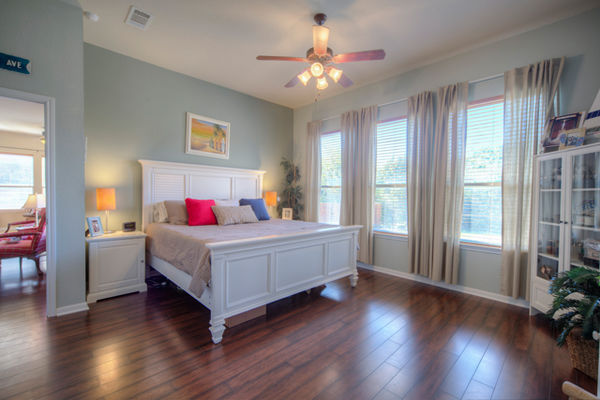Lighting for Real Estate Photography
Feb 8, 2016 08:52:07 #
dirtpusher wrote:
Great link! They also have a Flickr page where they showcase the group shots and host discussions. I would add that the Yongnuo flashes are very popular with the real estate guys because they are reliable and inexpensive, some of those guys will use 3 to 5 flash heads when shooting. http://www.flickr.com/groups/photographyforrealestateFeb 8, 2016 10:11:07 #
I help my wife with her real estate photography ... usually use some sort of wide angle, don't try to light the interior (able to utilize long shutter speeds everywhere necessary) HDR is a good tool just need to be careful to not go overboard. A couple of exterior pictures at or near dusk with interior lights on. Experiment with the interior lights, I always use RAW photos ... It is fun for me, but I do take my time certainly not ... not a pro but do receive some positive feedback ... have fun!!
Feb 8, 2016 10:30:30 #
Well, eventually, you'll need a more versatile lens.
On full frame Nikon the D750 you need a 14-24mm zoom.
On full frame Canon, you need a 16-35mm zoom.
On DX or APS-C, you need a 10-20, or 10-22mm zoom.
On Micro Four-Thirds, you need a 7-14mm zoom.
Just a couple of notes: All these camera formats are fine for real estate photography, since the images go on the web, are tiny, and will never be printed larger than about 6x8 inches.
The universal aspect ratio for real estate work is 4:3, making Micro Four-Thirds an obvious choice if you wish to "crop in camera." All 3:2 images get cropped on the sides, so keep that in mind as you work with your full frame. If you dive into the business, and want to keep using your D750 AND crop perfectly in the camera, you might consider a viewfinder mask laser-scribed with a 4:3 rectangle. Scott Helberg's the guy to do it: http://www.viewfindermasks.com
He made portrait masks for me. Even if the D750 finder screen is fixed, Scott knows how to remove it and scribe it. He's been doing this for two decades.
Most of the real estate photographers I've known use an on-camera mounted strobe, bounced off of white ceilings, where available. They open all blinds and curtains, turn on all lights, and mix in the strobe.
You can choose a Nikon high-end model flash, or its equivalent from Yongnuo. Personally, I'd rather have a couple of Yongnuos, so I have a spare. Get the most power output you can afford. You won't always need maximum output, but if you start photographing cavernous mansions...
Some folks are smart enough to cover the strobe with an 85B amber filter gel, when the room lighting is mostly incandescent. They will sometimes use a CC .30 Green gel over the flash to match cool white fluorescent lamps, if that is the predominant lighting. Then they'll do a custom white balance (JPEG) or a click white balance (raw) off of a neutral test target image captured in the same light, to bring the light in balance as best they can.
You can buy sheets of Rosco or Lee Filters from most major camera supply dealers. Their web sites list ALL their options:
http://www.rosco.com/filters/cinegel.cfm?CategoryID=2
http://www.leefilters.com/index.php
Some folks will carry a kit of several photo grade daylight fluorescent CFL lamps, which blend really well with daylight and strobe. If the client is willing, you can change out their lightbulbs (temporarily) with your own CFLs to render the scene as faithfully as possible. You can also use these lamps in clamp-on fixtures or soft boxes for supplementary lighting.
Such lamps are sold by Alzo Digital and others: http://www.alzodigital.com/online_store/light_bulbs_compact_fluorescent-daylight.htm
Oh, you can also use a tripod and experiment with HDR or just use long exposures.
Good luck!
On full frame Nikon the D750 you need a 14-24mm zoom.
On full frame Canon, you need a 16-35mm zoom.
On DX or APS-C, you need a 10-20, or 10-22mm zoom.
On Micro Four-Thirds, you need a 7-14mm zoom.
Just a couple of notes: All these camera formats are fine for real estate photography, since the images go on the web, are tiny, and will never be printed larger than about 6x8 inches.
The universal aspect ratio for real estate work is 4:3, making Micro Four-Thirds an obvious choice if you wish to "crop in camera." All 3:2 images get cropped on the sides, so keep that in mind as you work with your full frame. If you dive into the business, and want to keep using your D750 AND crop perfectly in the camera, you might consider a viewfinder mask laser-scribed with a 4:3 rectangle. Scott Helberg's the guy to do it: http://www.viewfindermasks.com
He made portrait masks for me. Even if the D750 finder screen is fixed, Scott knows how to remove it and scribe it. He's been doing this for two decades.
Most of the real estate photographers I've known use an on-camera mounted strobe, bounced off of white ceilings, where available. They open all blinds and curtains, turn on all lights, and mix in the strobe.
You can choose a Nikon high-end model flash, or its equivalent from Yongnuo. Personally, I'd rather have a couple of Yongnuos, so I have a spare. Get the most power output you can afford. You won't always need maximum output, but if you start photographing cavernous mansions...
Some folks are smart enough to cover the strobe with an 85B amber filter gel, when the room lighting is mostly incandescent. They will sometimes use a CC .30 Green gel over the flash to match cool white fluorescent lamps, if that is the predominant lighting. Then they'll do a custom white balance (JPEG) or a click white balance (raw) off of a neutral test target image captured in the same light, to bring the light in balance as best they can.
You can buy sheets of Rosco or Lee Filters from most major camera supply dealers. Their web sites list ALL their options:
http://www.rosco.com/filters/cinegel.cfm?CategoryID=2
http://www.leefilters.com/index.php
Some folks will carry a kit of several photo grade daylight fluorescent CFL lamps, which blend really well with daylight and strobe. If the client is willing, you can change out their lightbulbs (temporarily) with your own CFLs to render the scene as faithfully as possible. You can also use these lamps in clamp-on fixtures or soft boxes for supplementary lighting.
Such lamps are sold by Alzo Digital and others: http://www.alzodigital.com/online_store/light_bulbs_compact_fluorescent-daylight.htm
Oh, you can also use a tripod and experiment with HDR or just use long exposures.
Good luck!
Feb 8, 2016 10:53:08 #
katherineivey wrote:
Almost identical to my process, except I use a couple of off-camera flash. The flash results in better color balance and less noise from the HDR (I use fusion rather than tonemapping).I have a Canon 60D and use a Canon 10-22 mm lens that I love for real estate. Always on a tripod and always use bracketing for HDR processing in Photomatix. My website is kativeyphotography.com where I have photos posted. I always turn on all lights and don't use flash.
Feb 8, 2016 11:20:19 #
Thank you.....I will check out the lens. Not sure I can afford invisible pants and shoes :)
Feb 8, 2016 11:23:07 #
Oh WOW !! so much great advice. I need to take some time and really digest everything. Thank you so much everyone
Feb 8, 2016 11:28:01 #
Lots of good tips here today!
I shoot real estate and use a Nikon D750 with a Sigma 12-24mm lens. To minimize distortion, I try to shoot closer to 24mm than 12mm. KEEP THE CAMERA LEVEL!! If you do not, vertical lines (walls, pictures, windows) will be curved or not straight up and down. You can fix that in LR, Adobe Camera RAW and PS but you will lose some of your frame. Keep the camera level! I, of course, use a tripod and shoot five bracketed exposures outdoors and 3 to 5 indoors. I typically add one stop of exposure compensation indoors. I don't worry too much about windows...clients don't pay enough for the time required the make the windows perfect in post. I post process with Photomatix (mild tone mapping), Adobe Camera RAW and PS CS6. I batch resize to 640 x 427px using Photoshop. My images show up in MLS at 6 x 4 ratio and are NOT cropped to 4 x 3. (attached photos are MLS sized)
I shoot real estate and use a Nikon D750 with a Sigma 12-24mm lens. To minimize distortion, I try to shoot closer to 24mm than 12mm. KEEP THE CAMERA LEVEL!! If you do not, vertical lines (walls, pictures, windows) will be curved or not straight up and down. You can fix that in LR, Adobe Camera RAW and PS but you will lose some of your frame. Keep the camera level! I, of course, use a tripod and shoot five bracketed exposures outdoors and 3 to 5 indoors. I typically add one stop of exposure compensation indoors. I don't worry too much about windows...clients don't pay enough for the time required the make the windows perfect in post. I post process with Photomatix (mild tone mapping), Adobe Camera RAW and PS CS6. I batch resize to 640 x 427px using Photoshop. My images show up in MLS at 6 x 4 ratio and are NOT cropped to 4 x 3. (attached photos are MLS sized)



Feb 8, 2016 13:13:58 #
I do some real estate photography. I use a Canon MarkIV usually with an 18-40mm and a 28-200 mm lenses. I have so far only had to use my Nissan flash with a difusser. I take my lighting kit with me just in case I need it. I have so far gotten good results. However, I do like some of the suggestions here and will give some a try. Thank you for the suggestions.
Feb 8, 2016 13:20:58 #
dynaquest1 wrote:
Your help is really appreciatedI shoot real estate and use a Nikon D750 with a Si... (show quote)
Feb 8, 2016 13:25:06 #
PhotoArtsLA wrote:
What an impressive work ! Great suggestions and I'm trying to glean as much as I canIt depends on what time you are able to shoot. Whe... (show quote)
Feb 8, 2016 13:43:12 #
sirlensalot
Loc: Arizona
A few years ago, I was considering doing RE on a full-time basis. I had a chat with the owner of a nearby company and he took me to a daytime shoot to observe how he wanted it done. Ultimately, I was not selected because of the age of my equipment, and the fact I chose not to purchase a Canon 5D Mk III and a 16-35 f/2.8 lens. He did say a few of his photographers were still using the Mk II, but it still left my old 5D out of contention, which I had used with a Tokina 19-35 f/3.5-4.5 on a few RE jobs on my own.
For twilight shoots, they used Home Depot work lights - the single lights that sat very low to the ground which they hid between shrubs and house to light the home exterior. A few hundred feet of 100', 50', and a couple of 25' extension cords added to the kit. Guessing no more than 300' total.
Tripods are usually used for front exterior shots, mostly due to harsh lighting, so HDR was always used for the front shots to minimize shadows and highlights. They used 5 shots.
He used one external flash mounted to the camera. He used mainly manual mode for interior shots - mostly at 1/4 power mixing ambient light with flash. Of course that will change depending on location, sun, time of day, etc. All interior shots were hand held. Important to label bedrooms and bathrooms for any job.
That's the highlights of how one company does it.
To do it on the cheap? - your camera is all you will ever need for RE. With the 24-120, respectfully suggest this is a minimum for RE. All you can do is try it and see how it works and go from there. Flashes - really depends on your style of shooting. Suggest maybe a 3rd party dedicated flash like a Yongnuo or Neewer. For RE, manual flash works better IMO and is much cheaper.
Tripod - a must. Look for a deal on Craigslist. Need something fairly light, portable, quick to set up and take down.
Post processing program - Really cheap - Picasa or Gimp (free).
Lightroom is probably the most popular if you had to use one only.
It's been awhile, so I am probably leaving out a lot. Guessing tons more better advice out there, but hope this helps a little.
For twilight shoots, they used Home Depot work lights - the single lights that sat very low to the ground which they hid between shrubs and house to light the home exterior. A few hundred feet of 100', 50', and a couple of 25' extension cords added to the kit. Guessing no more than 300' total.
Tripods are usually used for front exterior shots, mostly due to harsh lighting, so HDR was always used for the front shots to minimize shadows and highlights. They used 5 shots.
He used one external flash mounted to the camera. He used mainly manual mode for interior shots - mostly at 1/4 power mixing ambient light with flash. Of course that will change depending on location, sun, time of day, etc. All interior shots were hand held. Important to label bedrooms and bathrooms for any job.
That's the highlights of how one company does it.
To do it on the cheap? - your camera is all you will ever need for RE. With the 24-120, respectfully suggest this is a minimum for RE. All you can do is try it and see how it works and go from there. Flashes - really depends on your style of shooting. Suggest maybe a 3rd party dedicated flash like a Yongnuo or Neewer. For RE, manual flash works better IMO and is much cheaper.
Tripod - a must. Look for a deal on Craigslist. Need something fairly light, portable, quick to set up and take down.
Post processing program - Really cheap - Picasa or Gimp (free).
Lightroom is probably the most popular if you had to use one only.
It's been awhile, so I am probably leaving out a lot. Guessing tons more better advice out there, but hope this helps a little.
Feb 8, 2016 13:59:38 #
katherineivey wrote:
Thank you for your website info. What a difference in the methods you illustratedMy website is kativeyphotography.com where I have photos posted.
Feb 8, 2016 14:00:30 #
Thank you for your website info. What a difference in the methods you illistrated
Feb 8, 2016 14:04:40 #
Feb 8, 2016 14:05:33 #
DavidPine wrote:
Thank you for your advice. Your time is appreciated.I am a professional real estate and architectural ... (show quote)
If you want to reply, then register here. Registration is free and your account is created instantly, so you can post right away.





